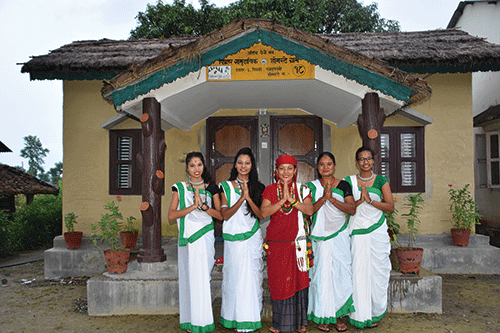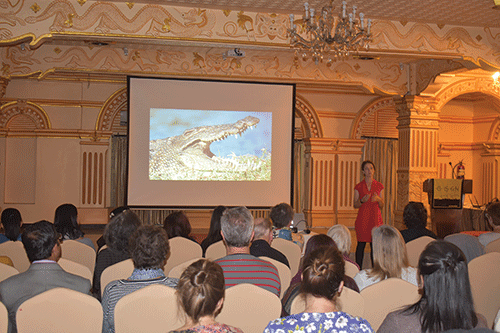
Active in the Annapurna Conservation Area Project in its early years, Shailendra Thakali reminisces about the beginning days, as well as what has changed for the better.
ShailendraThakali has led an interesting life—from his origins in Jomsom, Mustang, and on to New Zealand, and then back to Nepal where, in the many years since, he has been integrally involved in conservation and tourism, and can be accurately described as one of Nepal’s conservation pioneers.
Shailendra was one of the first field officers working for the Annapurna Conservation Area Project (ACAP) in 1990. That was the time when ACAP was moving out of the pilot program and into the first phase extension, and where he began his professional conservation career.
My first question, of course, is what led him to go into this field?
“I was a science student, and ACAP had the goal of involving local people in the management of the conservation area,” he told me.“They wanted to develop local professionals who could work for ACAP and manage the local conservation. ACAP was launched in 1986, and I and two others got selected for a scholarship by the then King Mahendra Trust for Nature Conservation (now National Trust for Nature Conservation). We were sent to New Zealand for a course in Protected Area Planning and Management.”
He and two fellow students were later joined by two others, and they studied there for four years. He got his first degree from Lincoln University, near Christchurch. Lincoln University had a very successful course in park management; so much so, that at that time, 95% of people working in New Zealand’s national parks had gone through that training course. They werethe leaders in training for National Park Rangers (known in Nepal as National Park Wardens).
At the time, Sir Edmund Hillary was New Zealand’s ambassador to Nepal and India, and he was the one to provide those five scholarships, the recipients (Shailendra and the others) selected by the Trust.

ACAP is considered to be a success story in the field of conservation and tourism, but why has it been more so than other programs? According to Shailendra, it was successful for a number of reasons—the primary one being that it was the first protected area in Nepal that was designed to involve local people in the management. Also, ACAP was the first protected area that tried to integrate both the conservation and development needs in a balanced way. And, finally, it was the first protected area that was managed by an NGO. I hadn’t realized before this that the Trust is in fact an NGO, though slightly different from other NGOs,in that it was enacted by a special act of parliament.
I asked Shailendra if he thought it was particularly well received, because it made the effort to engage with and involve the local community.
“Prior to ACAP, national parks worldwide had adopted what they call the ‘fence and fines approach,’which was basically excluding people, seeing them as a problem rather than a part of the solution, rather than working with them to find solutions and promote local guardianship,” he said. “ACAP was the first protected area, at least in Nepal, to integrate conservation and development, and to involve locals in the decision making process. At the time, those were very innovative ideas. Today, you find it in many other sectors, but during that time, protected areas were protected areas, and people were excluded from that system. Now, we know that if you really want to protect and sustain goals in the long term, you need to get local people involved in the decisions you are making.”

In ACAP, there was people participation, and the professionals were seen as matchmakers to bring government and donors together to achieve long-term conservation goals. The concept of sustainability was emphasized right from the beginning. Again, now these things sound like common sense to most of us, but at the time these were revolutionary ideas.
The Government of Nepal also gave ACAP permission to collectan entry fee from tourists visiting the area; the money was used 100 % by the project to support many varied small-scale conservation and development activities in the area. Some of these projects include promoting solarsystems, fuel efficient stoves, alternate fuels, school support, trail repairs, micro-hydro projects, clean-up campaigns, fencing, forest patrolling and protection activities, anti poaching activities, and numerous others.
By anybody’s standards, this is, and continues to be, a success story, and it’s still going strong. The government has a plan to hand over ACAP totally to the local people, as they have done with the management of the Kanchenjunga Conservation Area, where they created a council and regulations to empower them. The council there is fully led by local people.

I also asked Shailendra if he is still involved in conservation. His reply: “Not as actively as I would like to be, but it is part of my training and my passion, and since I am from a conservation area, I feel that I have a very high interest and stake in this. Whatever goes on in the Annapurna area, I follow it in the news and with my former colleagues; see how it’s going, and if I can be of any help. I am especially concerned with ensuring that this whole management system is turned over to the local people as was originally intended nearly 31 years ago.”
And how does tourism fit into all this? According to Shailendra, in the1980s, tourism was viewed in a very negative light from an environmental and conservation point of view: it was blamed for accelerating deforestation, increasing pollution, and having an adverse impact on local culture. The concern being that it was the goose that laid the golden egg, but could also foul its own nest. When ACAP started, one of the mandates of the program was to manage tourism in a sustainable manner, and that’s why all these programs, such as alternate energy, to reduce pressure on forests, etc. were started.
As an example, now there are very few lodges in the Annapurna area that use firewood; since the new road has been built, it’s easier and cheaper to transport LPG gas and other fuels. So, it’s been a success in reducing deforestation. Before, there was no alternative to firewood, but now dependency on that as a fuel source has gone down.
When ACAP first started, the people who opened lodges had no idea how they should be run, and just saw tourists as an opportunity to make some quick money, but now there are proper toilets and washrooms as well as waste management, all encouraged by proper training.

Back in 1986, the Annapurna area received somewhere between 30-35,000 visitors a year; after conservation was implemented, tourism started to grow, and now they receive more than 100,000 per year. It dipped a little after the conflict and the earthquake, but overall,it has remained steady, which is pretty amazing.
Now if you go around Annapurna, it’s a lot cleaner than it used to be 30 years ago, according to Shailendra. He is aware of the concern among local people and lodge owners whoare afraid that the newly builtnetwork of roads might affect tourism, especially the Annapurna Circuit Trek. But,this is something that Shailendra does not agree with at all. In fact, he states that the figures show that the total number of tourists has not gone down, but has increased over the years, particularly if you include domestic tourists. In the past, Nepalis who went to Mustang were primarily pilgrims, older people on the way to Muktinath. But now, he says that you find lots of young Nepalis, students, visiting places like Mustang andManang. The number of regional tourists from India and China has also increased. And if you compare those types of tourists, the lodge owners will tell you that domestic and Indian tourists usually spend more on food and drink than the foreigners, who tend to be budget travelers.
So, in his opinion, the road has definitely not been a detriment, even if it has meant changes to tourism in the area. In the past, tourists used to take the bus from Kathmandu to Dumre, and then go anti-clockwise to Manang—from Dumre to Besisahar and so on. Then, over the ThorungLa Pass to Jomsom—a two to three week trek all in all, depending on which route you took. Now you can do the standard Annapurna trek in less than a week. Listening to this, it sounds like perhaps the road may have decreased the number of people who are doing the longer trek, but it also has the potential to make visiting the area available to a wider swathe of people, thereby increasing tourism overall.

Some final words: “People have not really changed the way theygo about tourism. They are waiting for tourists to come to their lodges so they can sell them food, accommodation; they are not really offering activities. The road has not changed the potential for exploration. Local tourism entrepreneurs need to think creatively to develop tourism products with matching services. The Annapurna trek used to be like a marathon—point A to B, and so on; people used to even compete to see how fast they could do the circuit. Now, there are new opportunities to explore and see villages and daily life in the area, but it needs to be tapped into by the locals. These opportunities are there. A road will never change tourism, but it will change the style of tourism and the tourism market segments. If you manage it well, it has the potential to scale it up—you can get a lot more people and have a bigger tourism economy, and a high impact on job creation and the local economy, provided these things are well managed. Annapurna has already succeeded where it comes to lessening the impact of tourism on the environment—it’s done that well, but now we need to explore the new opportunities that the road has brought, and maximize the benefits.” There’s a lot of wisdom here, from someone who has every right to be proud of the great amount of progress that has been made, and is now championing adaptability, change, and growth.










